From the "King of Copyright" to the "Institutional Paradise"? Can Pectra upgrades reshape the Ethereum ecosystem

Reprinted from panewslab
03/13/2025·1MAuthor: YBB Capital Researcher Ac-Core
1. Background of Pectra hard fork

Source: coinpedia
The Ethereum Pectra upgrade was launched on March 5. This upgrade combines Prague and Electra updates to optimize Ethereum's execution layer and consensus layer. The Pectra fork is a major upgrade of the Ethereum network, aiming to improve the ETH staking experience, enhance the scalability of the second layer (L2), and expand the network capacity, introducing 11 Ethereum improvement proposals. The upgrade process was implemented on the Holesky test network on February 24, 2024, and it was finally planned to deploy Pectra to the main network on April 8, 2024, provided that both the Holesky and Sepolia test networks have successfully completed the upgrade.
Pectra follows the Dencun upgrade implemented in March 2024. This time, according to ethereum.org content (see Reference 1), the Ethereum Pectra upgrade is expected to integrate a number of important Ethereum improvement proposals that will work together to solve challenges in scalability, security, and user experience. The upgrade of Pectra will be implemented in two phases:
Stage 1: mid-March 2025
-
Double the capacity of 2 layers: Increase the capacity of blobs in each block from 3 to 6, reducing congestion and reducing costs;
-
Account abstraction: allows payment of Gas fees using stablecoins such as USDC and DAI, providing more payment flexibility;
-
Increase the staking limit for verifiers: Increase the staking limit from 32 ETH to 2,048 ETH, allowing large-scale staking operations;
Phase 2: End of 2025 or early 2026
-
Implementation of Verkle tree: Replace Merkle-Patricia with more efficient data structures to improve data storage and synchronization;
-
Peer-to-peer data availability sampling (PeerDAS): Improves scalability by allowing nodes to verify transaction data without storing all data.
2. Specific contents of 11 improvement proposals for Pectra upgrades

Source: datawallet
Ethereum’s Pectra upgrade includes 11 EIPs (Ethereum Improvement Proposals). These improvement proposals aim to improve the scalability, security, account abstraction and validator staking mechanism of the network. The following will describe the key proposals of the improvement proposal (different researchers have different judgments on key proposals, and the following is only the views that I think are important proposals) and the personal views of the impact of the proposal on Ethereum’s development.
1. EIP-7702: Account Abstraction
Content: This proposal allows externally owned accounts (EOA) to perform some smart contract functions, making account operations more flexible, such as bulk transactions and sponsored Gas fees. This greatly enhances the wallet functionality, allowing it to support more operating modes.
Viewpoint: This proposal undoubtedly makes the account abstract wallet stronger, not only can it do regular transfer operations, but it can also perform some advanced functions like smart contracts, such as bulk transactions or asking others to help you pay Gas fees. (The related EIP-7840 provides a wider range of account functionality extensions, which may allow users to customize more complex account behaviors)
2. EIP-7251: Validator stake increases
Content: The maximum stake balance of the verifier has been increased from 32 ETH to 2048 ETH. This can simplify validator management, allowing larger validator nodes to reduce management complexity.
Viewpoint: The huge increase in the number of pledges has undoubtedly increased the centralization of Ethereum. The more concentrated nodes are, the more likely they are to do evil, and it also increases the profitability of the Ethereum market. The cost of nodes and MEV arbitrage will be greatly increased. Overall, it is no longer suitable for "ordinary people" and more suitable for institutions.
3. EIP-7002: Withdrawal Improvement
Content: Allows the execution layer address to trigger withdrawal operations, reduces the trust assumptions between the consensus layer and the execution layer, simplifies the withdrawal process and improves network flexibility.
Viewpoint: It is mainly to make withdrawal operations simpler and do not require complicated steps. Verifiers can withdraw money from the pledge more directly, reducing intermediate links.
4. EIP-6110: Verifier activation delay optimization
Content: The activation delay time of validator deposits has been reduced from about 9 hours to about 13 minutes, greatly improving the efficiency and flexibility of validator participation.
Viewpoint: New validators join the network significantly faster. From the perspective of storage management and contract storage cost, it will reduce costs, from the previous 9 hours to only 13 minutes. To a certain extent, it has also improved the utilization rate of Ethereum resources.
5. EIP-7691: Data Block Extension
Content: Increase data block capacity by 50%, which means that the network can process more transactions, improving overall scalability and transaction throughput.
Viewpoint: Ethereum's block size has increased by 50%, which means that the network can handle more transactions, especially during peak periods, the network will not be so easily blocked and the transaction speed will be faster. (The related EIP-7742 can dynamically adjust the capacity of blobs and adjust the maximum number of blobs and targets of each block, especially for L2)
6. EIP-7516: Improve MEV transparency
Content: Provides more information and transparency about the maximum extractable value of MEV, helping users and developers better understand and monitor MEV activities in the blockchain.
Viewpoint: It increases transparency to MEV, and also increases the difficulty of arbitrage like EIP-7251 above, but ensures the fairness of transactions at a huge cost.
7. EIP-7549: Gas Cost Adjustment
Content: By adjusting the Gas fee structure, the network fee mechanism will be further optimized, the network burden during peak periods will be reduced, and transaction fees will be more reasonable.
Viewpoint: Adjusting the Gas fee structure means that even if the network is busy, transaction fees will be more stable, reducing the situation where users pay high fees during peak periods. (EIP-6046 also involves adjustments to the Gas fee structure, but EIP-7549 proposes a more dynamic and flexible fee adjustment solution)
8. EIP-7685: Governance mechanism optimization
Content: Optimize network governance, enhance decentralized governance mechanisms, and make governance processes more transparent and efficient.
Viewpoint: Ethereum's governance method may become more transparent and efficient, especially the review and approval process of proposals, which will improve governance efficiency and make community decisions more flexible.
9. EIP-7021: Optimization of Verifier Punishment Mechanism
Content: Adjust the verifier's punishment mechanism to ensure that the verifier's behavior can be more in line with the interests of the network and reduce the impact of adverse behavior.
Viewpoint: The improved punishment mechanism will better constrain the behavior of verifiers, and is regarded as a supplementary mechanism for releasing the maximum staking balance from 32 ETH to 2048 ETH, thereby balancing the relationship between network security and verifier incentives and ensuring the stability of the consensus layer.
10. EIP-7683: Smart Contract Performance Optimization
Content: Optimize the execution efficiency of smart contracts, especially in terms of Gas consumption, reduce execution costs and improve the operation efficiency of smart contracts on the network.
Viewpoint: Smart contracts run more efficiently and consume less Gas costs. This may essentially be to improve the relevant mechanisms of Uniswap, reduce transaction costs, and increase transaction speed. The direct biggest beneficiary is DeFi applications.
11. EIP-6123: Cross-chain compatibility improvements
Content: Enhance the cross-chain compatibility of the Ethereum network with other blockchains, ensure that more cross-chain operations can be supported in the future, and promote interoperability between different blockchains.
Viewpoint: The compatibility of Ethereum and other blockchains has been enhanced, which has also optimized the account abstraction mechanism to a certain extent. In the future, it will be easier to transfer assets and operate between different blockchains, and the customization function will be enhanced.
3. Pectra double-layer upgrade

Source: cryptoticker
Pectra adopts a merged double-layer upgrade method of execution layer (Prague) and consensus layer (Electra) to solve the synchronization problems that may arise during separate upgrades in the past. Ethereum's execution layer and consensus layer often assume different functions, so these two levels were usually upgraded separately in history.
-
Execution layer (Prague): Responsible for handling user transactions, executing smart contracts and managing state changes. This is the part where users interact directly with Ethereum and is also the core layer that runs all decentralized applications (DApps) and smart contracts.
-
Consensus layer (Electra): manages verifiers through the PoS (Proof of Stake) mechanism to ensure the security of block generation and chain. This level is the basis for ensuring network consistency and security, and validators use pledges to ensure that their behavior is in the interests of the network.
Among them, the additional explanation is:
EIP-6110, EIP-7002 EIP-7251, EIP-7549, EIP-7685 and EIP-7691 require changes to the consensus layer of Ethereum.
EIP-2537, EIP-2935, EIP-6110, EIP-7002, EIP-7623, EIP-7685, EIP-7702 and EIP-7840 require changes to the execution layer of Ethereum 7623.
EIP-7623: Cross-chain message mechanism improvement
Improve the processing mechanism of cross-chain messages and improve the efficiency and security of cross-chain communication. The Pectra upgrade mainly focuses on the improvements of the execution layer and consensus layer within Ethereum, while EIP-7623 focuses on interaction with external blockchains, especially the optimization of cross-chain assets and information transmission.
EIP-2537: BLS12-381 Curve Operation
Introduce support for the BLS12-381 curve in Ethereum for encryption and zero-knowledge proofs. EIP-2537 is a proposal for the introduction of specific encryption curves that support cryptography, mainly serving verification and privacy-related functions. By contrast, proposals in Pectra upgrades involve more broadly transactions, Gas fee optimization and validator mechanisms.
EIP-2935: Verifier recovery mechanism
Provides a more flexible mechanism for nodes that lose their verifier identity to restore their qualifications. EIP-2935 focuses on the verification agent's recovery mechanism, ensuring that validators can continue to participate in consensus in certain circumstances, while EIP-7251 and EIP-7021 in Pectra focus more on improvements in the staking cap and punishment mechanism.
4. The impact of Pectra on Ethereum and crypto markets

Source: voiceofcrypto
DApps
Pectra hard forks bringing smart contract functionality into regular wallets can simplify the development process and expand the scope of possible applications. Features such as social recovery and transaction batching make it easier to create user-friendly DApps, whether it’s DeFi, GameFi or other applications, users can expect to experience a more reliable and efficient DApp on the Ethereum network.
But with this, the main dilemma faced by Ethereum itself is that the "parasitic" effect of L2 is too obvious. The L2 chain has attracted a large amount of DeFi activity, resulting in a reduction in transaction fees on the Ethereum main network and an increase in ETH inflation rate. Although the L2 chain is part of the Ethereum ecosystem, its centralized sorter and independent economic model have raised questions about the value of the Ethereum mainnet.
The long-term value of Ethereum
Many Ethereum holders are dissatisfied with the price performance of ETH during this cycle. Many people regard the upgrade of Pectra as a hope to change the rules of the ETH game, mainly improving real staking and L2 scalability. Overall, this Pectra upgrade has brought a lot of changes to Ethereum, making wallet operations more flexible as a whole, and can process transactions or sponsor Gas fees in batches. The staking restrictions for validators have been increased, the speed of withdrawals and joining the network has also been accelerated, and the operability has also become more convenient. The network's block capacity is relatively increased, making transaction processing faster and the gas fees are more stable, and will not suddenly become expensive during peak periods.
The significant increase in the pledge threshold has also increased the overall transparency of MEVs, increasing the cost of MEVs, and network governance has also become more transparent and efficient. In terms of smart contracts, execution will be more "money-saving" and cross-chain compatibility has also been improved. But regarding the expansion problem of Ethereum fragmentation, should the development route be based on the high throughput of a single network, rather than relying on the aggregation of multiple chains to solve it? These challenges will also become a shackle for the future development of Ethereum.
Solana's price surge is mainly due to high throughput, low transaction costs and backed by US capital. The liquidity of a single chain is complete and unified. Ethereum solved the scalability problem through L2, but made innovation "fragmented" and "replicated". The superior quality of a single network than the L2 aggregation path is reflected. From a market perspective, Ethereum’s biggest advantage at present is that it has the most complete and decentralized decentralized financial network, and DeFi is the greatest value of Ethereum.
Compromise to decentralization
The biggest advantage of this upgrade is that it enhances the overall security and scalability of Ethereum. However, the good aspects of EIP-7251 will potentially reduce the operating load on the network by merging the number of validators and reducing the burden of large memory. The bad aspects will undoubtedly deepen the centralization of Ethereum and completely become the home court of big investors and institutions.
But whether it can rely on the huge 2,048 ETH pledge, cut off the threshold for retail investors to attract investment from large capital, and turn to Solana and Sui to embrace US capital, thereby pushing up the price of ETH. The current Ethereum seems to be facing new problems, and narrative capabilities, centralized pull-up, and decentralized PoS staking have become the "new impossible triangle".
Where is the new narrative Polaris
Ethereum seems to be losing its direction, fragmented ETH has now inflation year by year, DeFi activity has moved to the second layer of chain, and the cost capture of the first layer has been greatly reduced. The second-layer chain is actually an independent blockchain, and the centralized sorter can be understood as a completely different blockchain network. The large amount of income earned by Base flows to Coinbase, Arbitrum's profits flow to Arbitrum DAO, and the profits flow completely out of the Ethereum layer.
Bitcoin has a clear Polaris “digital gold” and Solana’s Polaris is “Nasdaq on the chain.” Blockchain embraces AI, Solana relies on the rapid emergence of the narratives related to DeFAI and AI Agent, and the SOL/ETH exchange rate ratio has also made the dream of Solana, the biggest "Ethereum killer", come true. Metis' ReGenesis plan will transform into an AI public chain, and is also fighting DeFAI with intention as the center.
So what exactly is Ethereum’s North Star? Why do ETFs suffer repeated setbacks? The biggest root cause is the lack of pledge returns and centralized value attribution. The current form of Ethereum ETF does not allow investors to participate in pledge. In addition to missing a yield of about 3.5% by holding Ethereum through ETFs, additional management fees are required, and DeFi returns are not available.
Also in terms of value attribution, Ethereum's strong decentralized attribute makes it difficult for it to belong to any capital force, and "Wall Street Capital" has not yet truly "stealed" the fruits of decentralization. It only supports DApps through stablecoins and DeFi, but the Pectra upgrade will increase the maximum staking balance from 32 ETH to 2048 ETH. It seems that through staking as an exposure, it supports large-scale institutional participants to introduce real assets into Ethereum and develop RWA that is more in line with the Ethereum version. Therefore, in the short term, Ethereum Polaris may be ETF staking, which will increase the price expectations of Ethereum to the same important position as the implementation of Bitcoin strategic reserves.
References:
(1) https://eips.ethereum.org/EIPS/eip-7600
(2) https://ethroadmap.com/?ref=bankless.ghost.io#pectra%20sticky
(3) https://eips.ethereum.org/EIPS/eip-7742
(4) https://eips.ethereum.org/EIPS/eip-7702
(5) https://eips.ethereum.org/EIPS/eip-7685
(6) https://eips.ethereum.org/EIPS/eip-7251
(7) https://eips.ethereum.org/EIPS/eip-7002
(8) https://eips.ethereum.org/EIPS/eip-6110
(9) https://eips.ethereum.org/EIPS/eip-2935
(10) https://eips.ethereum.org/EIPS/eip-2537
(11) https://www.galaxy.com/insights/research/ethereum-all-core-developers-execution-call-187/

